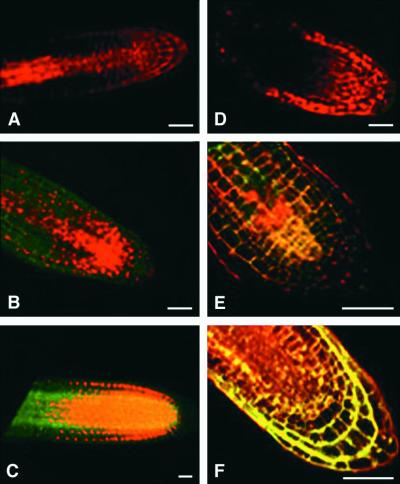Figure 7.
Fluorescein Diacetate and Propidium Iodide Test of Cell Viability in Root Tips of Arabidopsis Plants Treated with Various Levels of IAA and Untreated Controls.
Plants were either antisense ([A] to [C]) or wild-type plants ([D] to [F]). Because fluorescein diacetate must be transported into the nucleus and processed before it fluoresces green and propidium iodide always fluoresces red, this combination is excellent for determining cell viability. A living cell will show a combination of the red and green (yellow nucleus), and a dead cell will show only the red from the propidium iodide.
(A) Primary root of a seedling germinated on germination medium plus sucrose (GM-S) plus IAA (10−11 M). The root grew only 1 mm before it stopped growing and died.
(B) Lateral root of a seedling germinated on GM-S and transferred at 10 days to a plate containing GM-S plus IAA (10−11 M). Roots were stained with fluorescein diacetate and propidium iodide 4 days later. A root initiated during IAA treatment died soon after emergence from the epidermis.
(C) Lateral root from a seedling treated as in (A) except that no IAA was in the medium. This same pattern of staining was seen in primary root tips from transgenic seedlings grown in the absence of IAA (data not shown).
(D) Lateral root of a seedling germinated on GM-S and transferred at 10 days to a plate containing GM-S plus IAA (10−5 M). Roots were stained with fluorescein diacetate and propidium iodide 4 days later. A lateral root initiated during treatment died soon after emergence from the epidermis.
(E) Lateral root of a seedling germinated on GM-S and transferred at 10 days to a plate containing GM-S + IAA (10−11 M). Roots were stained with fluorescein diacetate and propidium iodide 4 days later. A lateral root initiated during treatment remained alive after the treatment.
(F) Wild-type root tip from a seedling treated as in (C).
Bars = 0.2 mm.

